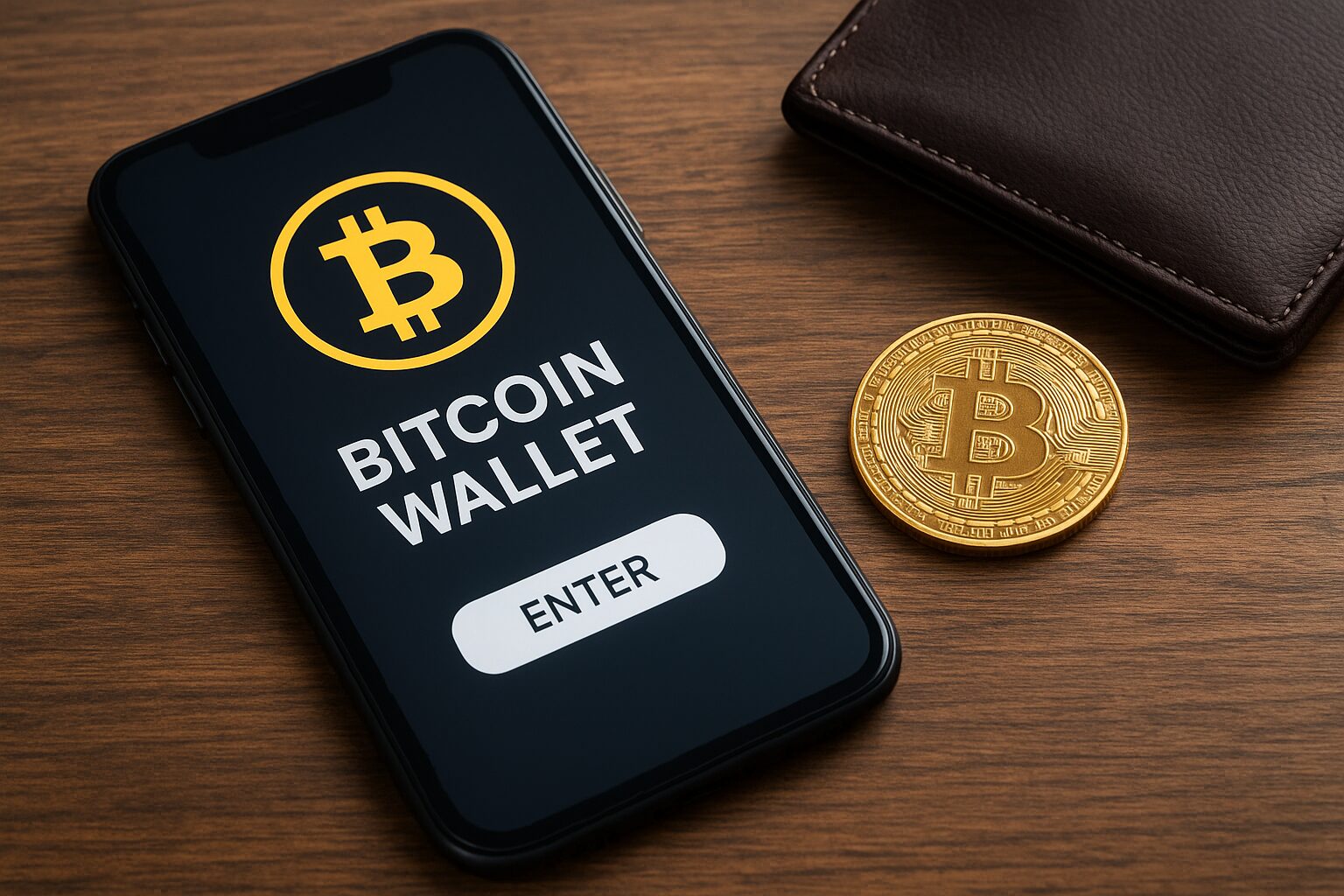If you’re new to cryptocurrency, one of the first things you’ll need is a Bitcoin wallet — your personal gateway to buying, storing, and sending Bitcoin securely. Think of it as your digital bank account, but without the need for a middleman like a traditional bank.
Having a secure wallet is essential. Without it, you can’t safely store your Bitcoin or protect it from hackers and scams. In this guide, you’ll learn what a Bitcoin wallet is, the different types available, and how to create one step-by-step — even if you’re a complete beginner.
By the end, you’ll know exactly which wallet fits your needs and how to keep your crypto safe.
What Is a Bitcoin Wallet?
A Bitcoin wallet is a digital tool that allows you to store, send, and receive Bitcoin (BTC). Instead of holding actual coins, it manages your private and public keys — digital codes that prove ownership of your Bitcoin on the blockchain.
- Public key: Works like your bank account number. It’s the address people use to send you Bitcoin.
- Private key: Like your ATM PIN — it’s what you use to access and send your Bitcoin. Never share this key with anyone.
Bitcoin Wallet vs. Bank Account
| Feature | Bitcoin Wallet | Traditional Bank |
|---|---|---|
| Ownership | 100% user-controlled | Bank-controlled |
| Access | Global, 24/7 | Depends on local banking hours |
| Security | Based on encryption | Backed by government & insurance |
| Privacy | Pseudonymous | Requires identity verification |
Unlike banks, Bitcoin wallets give you full control over your assets. You become your own bank — but with that freedom comes responsibility.
Types of Bitcoin Wallets
Choosing the right type of wallet is the first step to protecting your assets. Here are the main categories:
1. Hot Wallets (Online Wallets)
Hot wallets are connected to the internet, making them easy to access from your phone or computer.
- Examples: Trust Wallet, Coinbase Wallet, MetaMask (for Bitcoin & other coins).
- Pros: Fast access, user-friendly, ideal for daily transactions.
- Cons: Vulnerable to hacking if not secured properly.
2. Cold Wallets (Offline Wallets)
Cold wallets store your Bitcoin offline, offering the highest level of security.
- Examples: Ledger Nano X, Trezor Model T.
- Pros: Immune to online hacks, best for long-term storage.
- Cons: Costly and less convenient for frequent trading.
3. Desktop, Mobile, and Web Wallets
| Type | Access | Ideal For |
|---|---|---|
| Desktop | PC/Laptop | Privacy-focused users |
| Mobile | Smartphones | Everyday use |
| Web | Browsers | Beginners, fast setup |
Choosing the Right Bitcoin Wallet
Before creating a wallet, consider these key factors:
- Security: Look for 2FA, encryption, and seed phrase backup.
- Compatibility: Ensure it works on your device (Android, iOS, Windows, etc.).
- Cost: Free software wallets vs. paid hardware wallets.
- Ease of Use: Ideal for beginners with simple interfaces.
Recommended Wallets (2025)
- Hardware: Trezor Model T, Ledger Nano X
- Mobile: Trust Wallet, BlueWallet
- Web/Desktop: Electrum, Blockchain.com Wallet
Step-by-Step Guide: How to Create a Bitcoin Wallet
Let’s break it down into simple steps:
1. Choose Your Wallet Type
Decide whether you want a mobile, web, or hardware wallet. Beginners usually start with free mobile wallets like Trust Wallet or BlueWallet.
2. Download and Install
Go to the official app store or website.
Avoid third-party download links to prevent malware infections.
3. Create and Set Up
Open the app, select “Create New Wallet,” and follow the setup instructions.
4. Back Up Your Recovery Phrase
You’ll receive a 12–24 word recovery phrase. Write it down and store it offline. This is your lifeline if your device gets lost or stolen.
5. Secure Your Wallet
Add a strong password and enable two-factor authentication (2FA) for extra protection.
6. Verify and Test
Send a small amount of Bitcoin to your new wallet to make sure it’s working correctly.
How to Use Your Bitcoin Wallet
Once your wallet is set up:
- To receive Bitcoin: Copy your public address and share it with the sender.
- To send Bitcoin: Paste the recipient’s address, enter the amount, confirm, and send.
- To check your balance: Open your wallet app or device and view your holdings.
Most wallets also let you track your transaction history and monitor real-time Bitcoin prices.
Security Tips for Your Bitcoin Wallet
- Enable 2FA: Adds a second verification step for protection.
- Never share your private keys: Anyone with access can steal your funds.
- Backup your wallet regularly: Keep copies of your seed phrase offline.
- Use cold storage for large amounts: Hardware wallets are best for long-term investors.
- Avoid public Wi-Fi: Always use a secure internet connection.
Common Mistakes to Avoid
- Storing your seed phrase online or in cloud storage.
- Downloading wallets from fake websites.
- Forgetting to update your wallet software.
- Sending Bitcoin to wrong addresses (transactions are irreversible).
Avoiding these mistakes can save you from permanent losses.
Conclusion
Creating a Bitcoin wallet doesn’t have to be complicated.
You just need to:
- Choose your wallet type
- Set it up securely
- Back up your recovery phrase
- Protect your private keys
Once you have your wallet ready, you can safely buy, hold, and trade Bitcoin anytime.
Start today own your crypto, control your future.
Frequently Asked Questions (FAQs)
1. Do I need a wallet to buy Bitcoin?
Yes, you need a wallet to receive and store Bitcoin safely.
2. Are Bitcoin wallets free?
Most software wallets are free, but hardware wallets have a one-time purchase cost.
3. Can I have multiple Bitcoin wallets?
Yes, many users keep separate wallets for trading and savings.
4. What happens if I lose my private key?
You’ll lose access to your Bitcoin permanently. Always back up your recovery phrase.
5. Are mobile Bitcoin wallets safe?
Yes, if you use trusted apps and enable 2FA.
6. How do I recover my wallet?
Use your recovery phrase to restore it on a new device.
7. Can someone hack my wallet?
Only if they gain access to your device or private keys — keep them secure.
8. What’s the best wallet for beginners?
Trust Wallet or BlueWallet are simple and user-friendly options.
9. Can I store other cryptocurrencies in my Bitcoin wallet?
Some wallets support multiple assets, but others are Bitcoin-only.
10. Is a Bitcoin wallet anonymous?
Bitcoin transactions are pseudonymous — your identity isn’t shown, but transactions are public on the blockchain.
Disclaimer
This article is for educational purposes only and does not constitute financial advice. Cryptocurrency investments are volatile and involve risks. Always do your own research or consult a licensed financial advisor before making any investment decisions.



